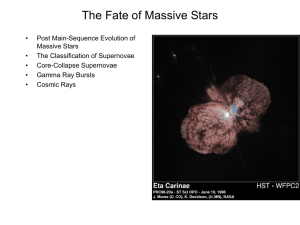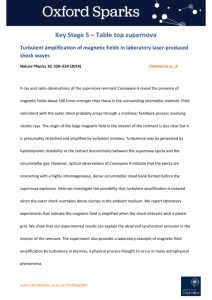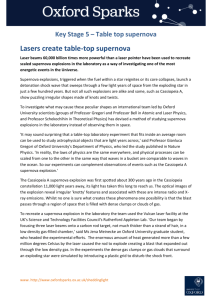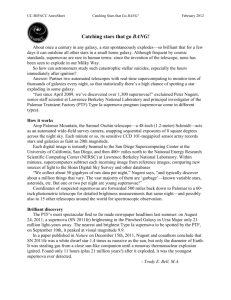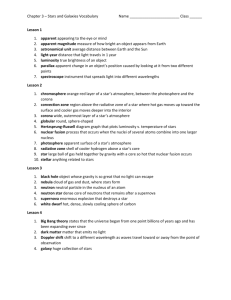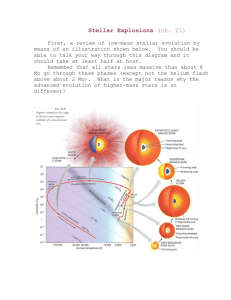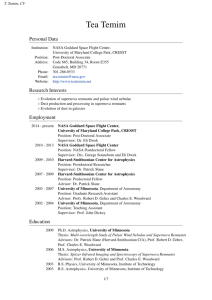the following release was received from the university of wisconsin
advertisement
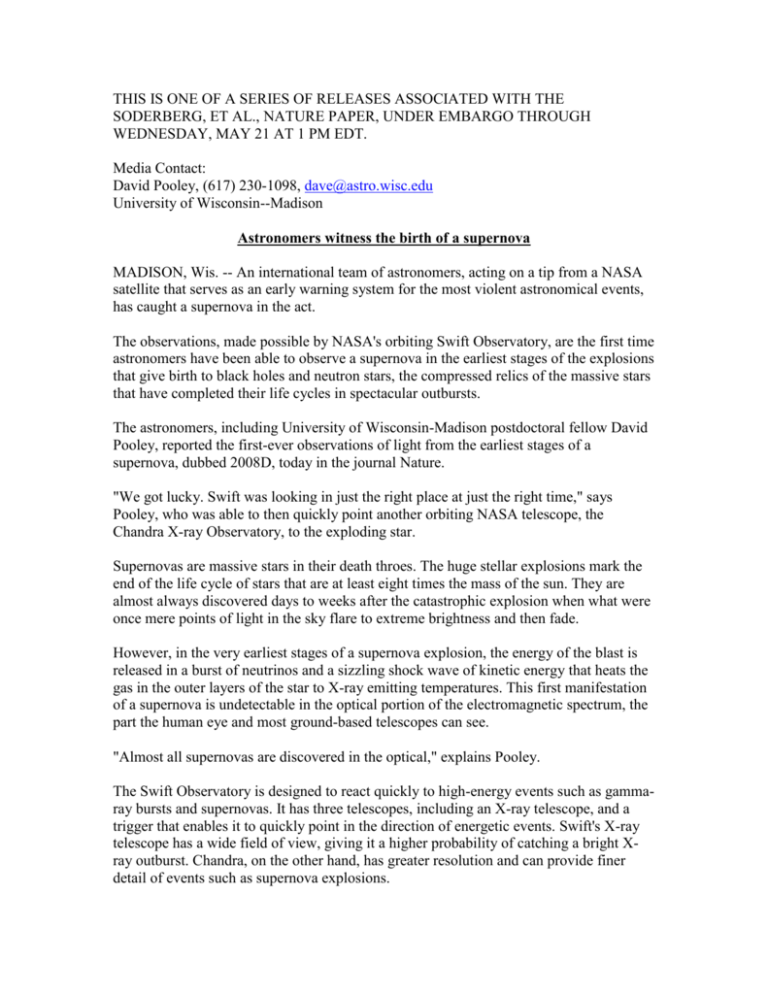
THIS IS ONE OF A SERIES OF RELEASES ASSOCIATED WITH THE SODERBERG, ET AL., NATURE PAPER, UNDER EMBARGO THROUGH WEDNESDAY, MAY 21 AT 1 PM EDT. Media Contact: David Pooley, (617) 230-1098, dave@astro.wisc.edu University of Wisconsin--Madison Astronomers witness the birth of a supernova MADISON, Wis. -- An international team of astronomers, acting on a tip from a NASA satellite that serves as an early warning system for the most violent astronomical events, has caught a supernova in the act. The observations, made possible by NASA's orbiting Swift Observatory, are the first time astronomers have been able to observe a supernova in the earliest stages of the explosions that give birth to black holes and neutron stars, the compressed relics of the massive stars that have completed their life cycles in spectacular outbursts. The astronomers, including University of Wisconsin-Madison postdoctoral fellow David Pooley, reported the first-ever observations of light from the earliest stages of a supernova, dubbed 2008D, today in the journal Nature. "We got lucky. Swift was looking in just the right place at just the right time," says Pooley, who was able to then quickly point another orbiting NASA telescope, the Chandra X-ray Observatory, to the exploding star. Supernovas are massive stars in their death throes. The huge stellar explosions mark the end of the life cycle of stars that are at least eight times the mass of the sun. They are almost always discovered days to weeks after the catastrophic explosion when what were once mere points of light in the sky flare to extreme brightness and then fade. However, in the very earliest stages of a supernova explosion, the energy of the blast is released in a burst of neutrinos and a sizzling shock wave of kinetic energy that heats the gas in the outer layers of the star to X-ray emitting temperatures. This first manifestation of a supernova is undetectable in the optical portion of the electromagnetic spectrum, the part the human eye and most ground-based telescopes can see. "Almost all supernovas are discovered in the optical," explains Pooley. The Swift Observatory is designed to react quickly to high-energy events such as gammaray bursts and supernovas. It has three telescopes, including an X-ray telescope, and a trigger that enables it to quickly point in the direction of energetic events. Swift's X-ray telescope has a wide field of view, giving it a higher probability of catching a bright Xray outburst. Chandra, on the other hand, has greater resolution and can provide finer detail of events such as supernova explosions. On Jan. 9, Swift was gathering data on another fairly recent supernova event in the nearby galaxy NGC 2770 when it detected the very early manifestation of supernova 2008D, situated some 90 million light years from Earth. Other telescopes, including the ground- based Gemini North Observatory, the National Science Foundation's Very Large Array radio telescope, and the orbiting Chandra X-ray Observatory were quickly brought to bear on the new supernova, gathering an unprecedented set of data on the earliest stages of a massive star in its death throes. UW-Madison's Pooley leads a quick-reaction Chandra X-ray Observatory program, a sort of astrophysics SWAT team, whose mission is to respond rapidly to the kinds of highenergy events Swift is capable of detecting. "The program is designed for events just like this," Pooley notes. "When Swift saw the X-ray emission, we were able to quickly point Chandra to ensure we could disentangle the supernova from any confusing sources" of X-rays in the galaxy. The observations made by Pooley and others provide the earliest picture to date of a supernova explosion. The data seem to neatly match predictions of how a type of star known as a Wolf-Rayet star, a massive star at an advanced stage of stellar evolution, would end its life in a supernova blast. "There is a massive star and the core collapses and sends out this tremendous shock wave, and when the shock wave gets through to the outer layers of the star, that's when we see the X-rays," Pooley says. "From our observation, we were able to infer the size and mass of the star and that matched up really reasonably well with our models of WolfRayet stars." While Swift had the good fortune to be pointed in the right direction when the supernova occurred, Pooley and the other authors of the Nature report say the supernova catch will enable future telescopes, such as the massive neutrino detector IceCube, now under construction at the South Pole, to obtain massive data sets on the high-energy neutrinos created in the blast, and provide even more detailed portraits of supernovas as they occur. "When supernovas like this collapse, they emit a huge burst of neutrinos," Pooley notes. "Ninety-nine percent of the energy (of a supernova) is carried away in neutrinos. If we have better and more accurate knowledge of when and where these happen, that would let an instrument like IceCube be more sensitive" and responsive to the events.

